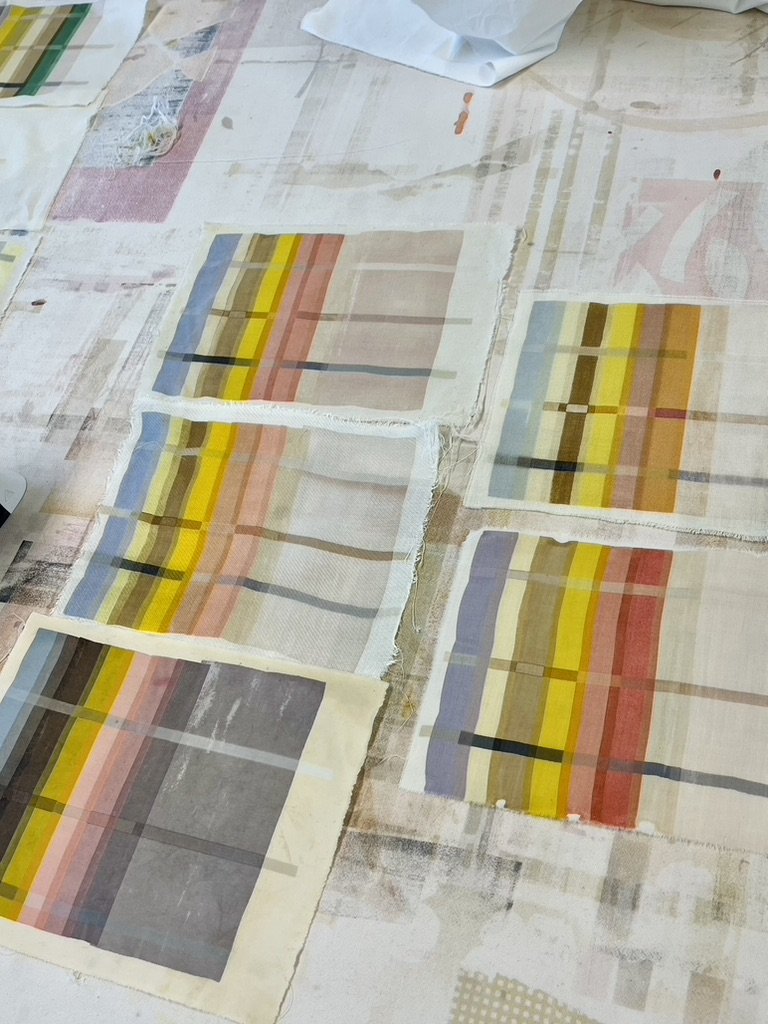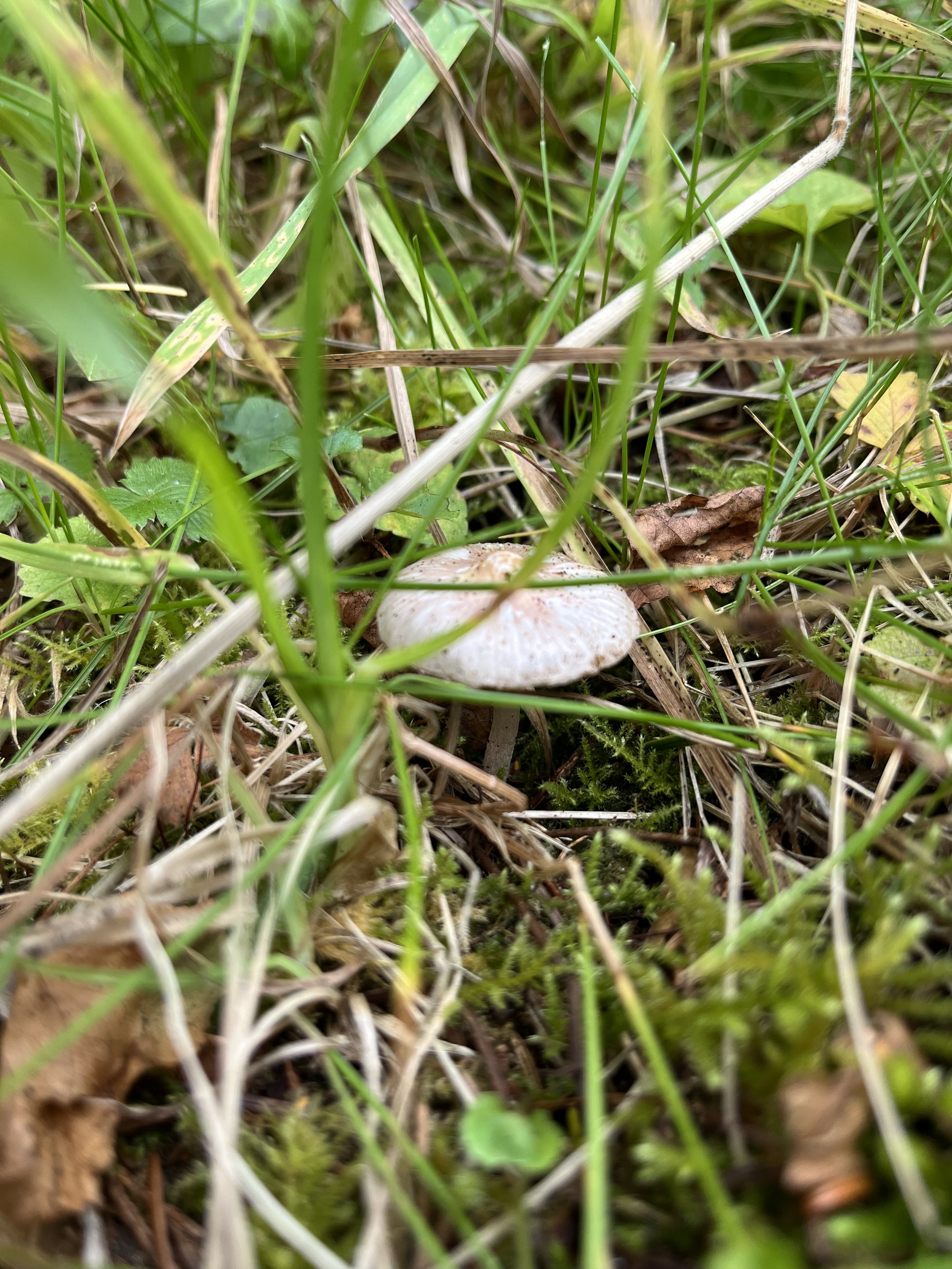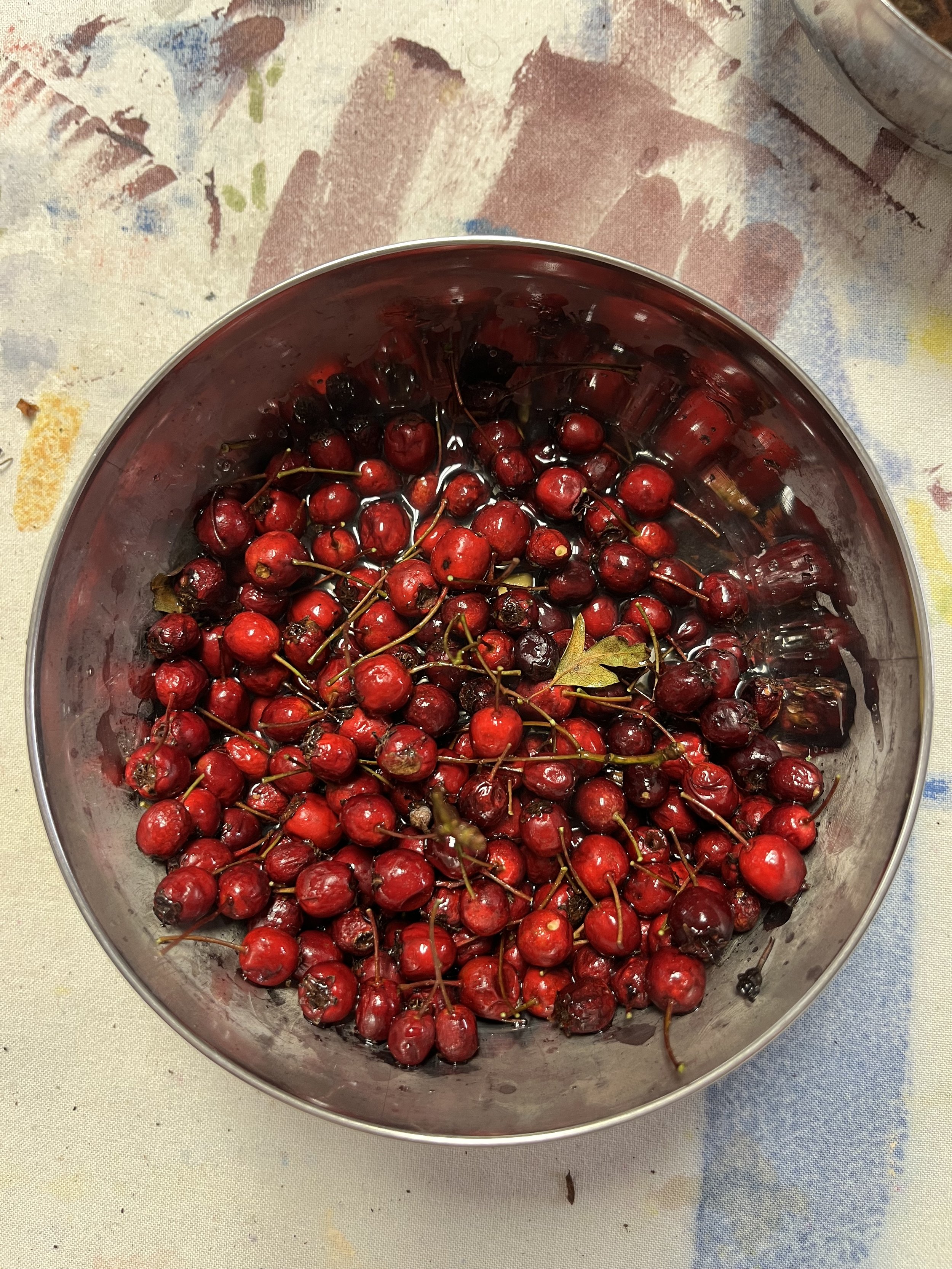In August 2024 I was granted funding by Creative Scotland for a period of research and development around screen printing with natural dyes. My goals were to expand my experience with using naturally sourced dye stuffs as an alternative to the synthetically produced Procion MX dyes I currently rely heavily upon.
Early experiments with making ink from rosehips
In the grand scheme of things, Procion dyes are not as toxic as other dyestuffs and being cold water dyes, they require less energy to give good colour. But I am interested in moving away from using materials that cannot be guaranteed to have not been created using the exploitation of workers or the over-consumption of raw materials. With this project I am looking to further develop printing techniques that champion the sourcing and brewing of colour/ inks by hand, while lessening the chance of potentially harmful chemicals entering water systems or the food chain.
A central part of my practice involves polychromatic dye printing. Currently, I achieve this by employing Procion (synthetic) dyes; mixing up individual colours and painting them onto screen in a similar way to watercolour on paper. I then use a plant based binder to print the artwork onto fabric before setting and finally washing out. This process transfers the dyes from the screen to the fabric permanently.
Painting with procion inks
Procion inks printed onto a cotton tee
This technique makes my work unique to my hand (unusually for screen printing) and is a core part of my output, but could I develop this polychromatic, monoprinting technique with natural dyes? That is the question I wanted to answer with the support of Creative Scotland’s funding.
Before embarking on this project I had started my adventures in natural dye with immersion dyeing fabrics using food waste. I think the skin/ pit of every avocado or onion I have eaten in the last 4 years has ended up in a dye pot. This is such an accessible entry point to natural dyeing and give beautiful, gentle pinks, yellows and greens and I can highly recommend giving it a try.
I had also done some experiments with making inks from avocado, onion and rosehips with very mixed results! It was clear that I needed some expert guidance to shore up my skills and confirm some of my thinking.
The answer was to take part in Ceres Studio’s excellent and informative courses on Natural Dye Printmaking. I signed up for both their introduction and master courses and found them absolutely fascinating. I learned a lot from Lara and Flo and they confirmed and enhanced a lot of my own previous personal research. The courses themselves deserve their own blog post, but in the meantime I can say that if you are considering stepping into natural dyes, absolutely make Lara and Flo your first port of call.
Sample from Ceres Studio’s course in natural dye printing, pre-set and washout
Natural dye print samples steam set and washed out
Returning to my home in Scotland from London I found myself inspired to begin foraging for natural dyestuffs, and because the courses took place in September and October I found I was surrounded by so many sources of potential colour. I suddenly started seeing elderberries everywhere I looked, and was frantically taking notes on different trees, berries, mushrooms and lichens.
Before I go any further I will go into my personal rules for foraging. I want to be as responsible and careful as possible with these precious natural resources.
Don’t pick anything you can’t identify
Only take from an area of abundance and don’t take more than 30% of the crop
Don’t damage surrounding plants/ insects/ animal habitats in the harvesting
With this in mind, here are some examples of what I foraged and attempted to extract colour from during autumn 2024, in rural Perthshire.
What didn’t work
Mushrooms
What is this guy? Answers on a postcard
I was initially very excited by all of the varieties of mushroom I found around my parent’s garden in Perthshire. However, I have found that mushroom identification and extracting colour from these incredible organisms is a complicated and in depth process that I would one day love to learn more about. It is an avenue of research that I look forward to exploring with the attention and expertise needed to really get to grips with the subject. One day!
Yew
Beautiful (and slightly poisonous) yew
Yew bark
I was also very excited by the yew tree in my parent’s garden, and taking care to use gloves to collect bark, needles and berries, I had visions of the stunning oranges I was going to make. Reader- I have quickly learned that natural dye does not work this way! It is one that I will come back to I think, but it doesn’t seem a particularly strong colour.
Lichens
A blackthorn tree dripping in lichen, in Perthshire
Much like fungi, I was initially very excited by the idea of dyeing with lichens. My home county of Perthshire seems to be brimming with them. I also read that a beautiful purple can be obtained. However after doing some research I learned how slow growing they are, and that some species may be protected. The colour may also be very fugitive/ short lived. It just didn’t seem like a responsible use of the plant.
Hawthorn and Sloes
Hawthorn thicket
Blackthorn/ Sloe trees
Hawthorn Berries
Sloeberries
Much like yew, these may be ones I come back to as I may have over watered my dyestuffs. But no particularly strong colour seems to come from the leaves, twigs or berries. If you know otherwise please do let me know your secrets in the comments! These are beautiful plants and I love being around them.
What did work
Elderberries
Simmering elderberries
A very reliable source of colour
Acorn & Oak Gall
I could not love the oak tree more
Iron machine part removed from the river
A big hunk of iron I pulled from the river Turret
The colours of rural Perthshire seem to be earthy, rich browns of tannin-y oaks, shades of subtle beiges and sandy ochres, and the rich dusky purple of elderberries.
Samples on iron, acorn and avocado dyed linens
Foraging for colour is cyclical, and goes with the seasons. This was my first year of experimentation and my first step into a rich, beautiful and fulfilling practice that feels alchemical. While I embarked on this journey I also continued my experiments with food waste, including a very exciting discovery from a bean I found in a local Asian food market. As my experiments went along, I also folded in some dye extracts to my library of natural colour. And looking forward, I can’t wait to experiment with more food/bio waste as the year warms up and crops begin to grow again.
I will go further into my other colour findings and how I went about tackling polychromatic printing with natural dyes in my next post. In the meantime, if you have any observations, advice or insights do share them in the comments!
I’m so happy I have taken these first steps into this fascinating and complex world. It’s given me a connectedness to my surroundings and a root in the landscape that I haven’t felt since I was a child. I hope you come along for the ride and feel as inspired as I do.




















